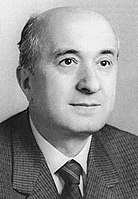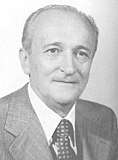1987 Italian general election
General elections were held in Italy on 14-15 June 1987, to select the Tenth Republican Parliament.[1] This election marked the final inversion of the trend of the entire republican history of Italy: for the first time, the distance between the Christian Democrats and the Communists grew significantly instead of decreasing. This was seen as the result of the deindustrialization of the country. The growth of the service sector of the economy, and the leadership of former PM Bettino Craxi, gave instead a new strength to the Socialists. A remarkable novelty was the rise of the new Green Lists, while a new party obtained its first two parliamentary seats: the Northern League.
| |||||||||||||||||||||||||||||||||||||||||
All 630 seats in the Chamber of Deputies 315 seats in the Senate | |||||||||||||||||||||||||||||||||||||||||
|---|---|---|---|---|---|---|---|---|---|---|---|---|---|---|---|---|---|---|---|---|---|---|---|---|---|---|---|---|---|---|---|---|---|---|---|---|---|---|---|---|---|
| Turnout | 88.8% | ||||||||||||||||||||||||||||||||||||||||
| |||||||||||||||||||||||||||||||||||||||||
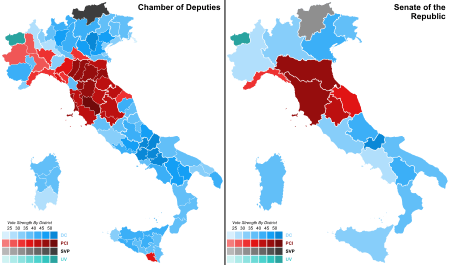 Results of the election in the Chamber and Senate. | |||||||||||||||||||||||||||||||||||||||||
| |||||||||||||||||||||||||||||||||||||||||
Electoral system
The pure party-list proportional representation had traditionally become the electoral system for the Chamber of Deputies. Italian provinces were united in 32 constituencies, each electing a group of candidates. At constituency level, seats were divided between open lists using the largest remainder method with Imperiali quota. Remaining votes and seats were transferred at national level, where they was divided using the Hare quota, and automatically distributed to best losers into the local lists.
For the Senate, 237 single-seat constituencies were established, even if the assembly had risen to 315 members. The candidates needed a landslide victory of two thirds of votes to be elected, a goal which could be reached only by the German minorities in South Tirol. All remained votes and seats were grouped in party lists and regional constituencies, where a D'Hondt method was used: inside the lists, candidates with the best percentages were elected.
Historical background
In the 1980s, for the first time since 1945, two governments were led by non-Christian Democrat Premiers: the republican Giovanni Spadolini and the socialist Bettino Craxi; the Christian Democracy remained however the main force supporting the government.
With the end of the Years of Lead, the Italian Communist Party gradually increased their votes under the leadership of Enrico Berlinguer. The Socialist party (PSI), led by Craxi, became more and more critical of the communists and of the Soviet Union; Craxi himself pushed in favour of US president Ronald Reagan's positioning of Pershing II missiles in Italy, a move the communists hotly contested.
In June 1984 Berlinguer, the charismatic Communist leader, suddenly left the stage during a speech at a public meeting in Padua: he had suffered a brain haemorrhage, and died three days later. More than a million citizens attended his funeral, one of the biggest in Italy's history. Alessandro Natta was appointed as new party's secretary. The public emotion caused by Berlinguer's death resulted in an extraordinary strength for the Communist Party in the 1984 European election: for the first time in Western Europe since the French election of 1956, and for the first time ever in Italian history, a Communist party received a plurality by a democratic vote.
In 1984, the Craxi government revised the 1927 Lateran Pacts with the Vatican, which concluded the role of Catholicism as Italy's state religion.
During this period, Italy became the fifth-largest industrial nation and gained entry into the G7.
Parties and leaders
Results
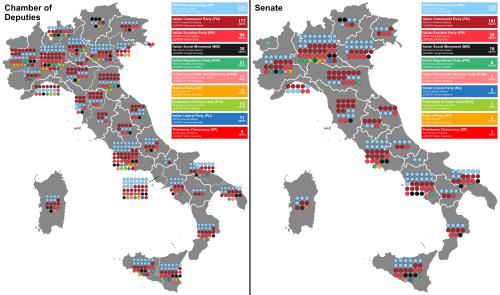
Chamber of Deputies
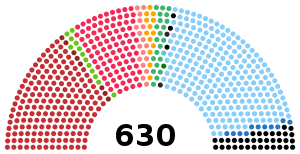 | |||||
| Party | Votes | % | Seats | +/− | |
|---|---|---|---|---|---|
| Christian Democracy (DC) | 13,233,620 | 34.31 | 234 | +9 | |
| Italian Communist Party (PCI) | 10,250,644 | 26.58 | 177 | −21 | |
| Italian Socialist Party (PSI) | 5,501,696 | 14.26 | 94 | +21 | |
| Italian Social Movement (MSI) | 2,281,126 | 5.91 | 35 | −7 | |
| Italian Republican Party (PRI) | 1,428,663 | 3.70 | 21 | −8 | |
| Italian Democratic Socialist Party (PSDI) | 1,140,209 | 2.96 | 17 | −6 | |
| Radical Party (PR) | 987,720 | 2.56 | 13 | +2 | |
| Federation of Green Lists (FLV) | 969,218 | 2.51 | 13 | New | |
| Italian Liberal Party (PLI) | 809,946 | 2.10 | 11 | −5 | |
| Proletarian Democracy (DP) | 641,901 | 1.66 | 8 | +1 | |
| Venetian League–United Pensioners (LV–PU) | 298,402 | 0.77 | 0 | ±0 | |
| South Tyrolean People's Party (SVP) | 202,022 | 0.52 | 3 | ±0 | |
| Lombard League (LL) | 186,255 | 0.48 | 1 | New | |
| Sardinian Action Party (PSd'Az) | 169,978 | 0.44 | 2 | +1 | |
| Piedmont – Regional Autonomy | 72,064 | 0.19 | 0 | New | |
| Piedmont | 61,701 | 0.16 | 0 | New | |
| Hunting, Fishing, Environment (CPA) | 55,977 | 0.14 | 0 | New | |
| Aosta Valley (VdA) | 41,707 | 0.11 | 1 | ±0 | |
| Others | 238,272 | 0.63 | 0 | ±0 | |
| Invalid/blank votes | 2,015,065 | – | – | – | |
| Total | 40,586,573 | 100 | 630 | ±0 | |
| Registered voters/turnout | 45,692,417 | 88.83 | – | – | |
| Source: Ministry of the Interior | |||||
Senate of the Republic
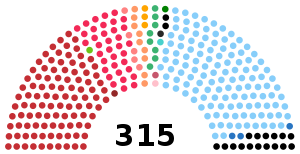 | |||||
| Party | Votes | % | Seats | +/− | |
|---|---|---|---|---|---|
| Christian Democracy (DC) | 10,897,036 | 33.62 | 125 | +5 | |
| Italian Communist Party (PCI) | 9,181,579 | 28.33 | 101 | −6 | |
| Italian Socialist Party (PSI) | 3,535,457 | 10.91 | 36 | −2 | |
| Italian Social Movement (MSI) | 2,121,026 | 6.54 | 16 | −2 | |
| Italian Republican Party (PRI) | 1,248,641 | 3.85 | 8 | −2 | |
| PSI–PSDI–PR | 962,215 | 2.97 | 9 | ±0 | |
| Italian Democratic Socialist Party (PSDI) | 764,370 | 2.36 | 5 | −3 | |
| Italian Liberal Party (PLI) | 700,330 | 2.16 | 3 | –3 | |
| Federation of Green Lists (FLV) | 634,182 | 1.96 | 1 | New | |
| Radical Party (PR) | 572,461 | 1.77 | 3 | +2 | |
| Proletarian Democracy (DP) | 493,667 | 1.52 | 1 | +1 | |
| Venetian League–United Pensioners (LV–PU) | 298,552 | 0.92 | 0 | −1 | |
| South Tyrolean People's Party (SVP) | 171,539 | 0.53 | 2 | −1 | |
| Lombard League (LL) | 137,276 | 0.42 | 1 | New | |
| Sardinian Action Party (PSd'Az) | 124,266 | 0.38 | 1 | ±0 | |
| Secular-Socialist Alliance | 84,883 | 0.26 | 1 | New | |
| Piedmont – Regional Autonomy | 60,742 | 0.19 | 0 | New | |
| PSI–PSDI–PR–Greens | 58,501 | 0.18 | 1 | ±0 | |
| Pensioners Popular Alliance | 51,790 | 0.16 | 0 | New | |
| Piedmont | 51,340 | 0.16 | 0 | New | |
| Molisean Democratic Alliance | 49,297 | 0.15 | 0 | New | |
| Hunting, Fishing, Environment (CPA) | 41,135 | 0.13 | 0 | New | |
| Aosta Valley (VdA) | 35,830 | 0.11 | 1 | ±0 | |
| Others | 137,746 | 0.43 | 0 | ±0 | |
| Invalid/blank votes | 2,007,369 | – | – | – | |
| Total | 34,421,230 | 100 | 315 | ±0 | |
| Registered voters/turnout | 38,951,485 | 88.37 | – | – | |
| Source: Ministry of the Interior | |||||
References
- Dieter Nohlen & Philip Stöver (2010) Elections in Europe: A data handbook, p1048 ISBN 978-3-8329-5609-7
